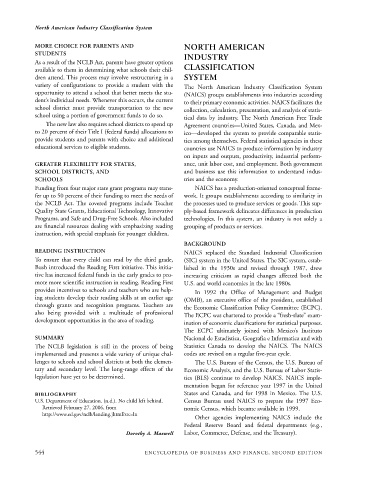Page 567 - Encyclopedia of Business and Finance
P. 567
eobf_N 7/5/06 3:16 PM Page 544
North American Industry Classification System
MORE CHOICE FOR PARENTS AND NORTH AMERICAN
STUDENTS
INDUSTRY
As a result of the NCLB Act, parents have greater options
available to them in determining what schools their chil- CLASSIFICATION
dren attend. This process may involve restructuring in a SYSTEM
variety of configurations to provide a student with the The North American Industry Classification System
opportunity to attend a school that better meets the stu- (NAICS) groups establishments into industries according
dent’s individual needs. Whenever this occurs, the current
to their primary economic activities. NAICS facilitates the
school district must provide transportation to the new collection, calculation, presentation, and analysis of statis-
school using a portion of government funds to do so.
tical data by industry. The North American Free Trade
The new law also requires school districts to spend up Agreement countries—United States, Canada, and Mex-
to 20 percent of their Title I (federal funds) allocations to ico—developed the system to provide comparable statis-
provide students and parents with choice and additional tics among themselves. Federal statistical agencies in these
educational services to eligible students. countries use NAICS to produce information by industry
on inputs and outputs, productivity, industrial perform-
GREATER FLEXIBILITY FOR STATES, ance, unit labor cost, and employment. Both government
SCHOOL DISTRICTS, AND and business use this information to understand indus-
SCHOOLS tries and the economy.
Funding from four major state grant programs may trans- NAICS has a production-oriented conceptual frame-
fer up to 50 percent of their funding to meet the needs of work. It groups establishments according to similarity in
the NCLB Act. The covered programs include Teacher the processes used to produce services or goods. This sup-
Quality State Grants, Educational Technology, Innovative ply-based framework delineates differences in production
Programs, and Safe and Drug-Free Schools. Also included technologies. In this system, an industry is not solely a
are financial resources dealing with emphasizing reading grouping of products or services.
instruction, with special emphasis for younger children.
BACKGROUND
READING INSTRUCTION NAICS replaced the Standard Industrial Classification
To ensure that every child can read by the third grade, (SIC) system in the United States. The SIC system, estab-
Bush introduced the Reading First initiative. This initia- lished in the 1930s and revised through 1987, drew
tive has increased federal funds in the early grades to pro- increasing criticism as rapid changes affected both the
mote more scientific instruction in reading. Reading First U.S. and world economies in the late 1980s.
provides incentives to schools and teachers who are help- In 1992 the Office of Management and Budget
ing students develop their reading skills at an earlier age
(OMB), an executive office of the president, established
through grants and recognition programs. Teachers are the Economic Classification Policy Committee (ECPC).
also being provided with a multitude of professional
The ECPC was chartered to provide a “fresh-slate” exam-
development opportunities in the area of reading.
ination of economic classifications for statistical purposes.
The ECPC ultimately joined with Mexico’s Instituto
SUMMARY Nacional de Estadistica, Geografia e Informatica and with
The NCLB legislation is still in the process of being Statistics Canada to develop the NAICS. The NAICS
implemented and presents a wide variety of unique chal- codes are revised on a regular five-year cycle.
lenges to schools and school districts at both the elemen- The U.S. Bureau of the Census, the U.S. Bureau of
tary and secondary level. The long-range effects of the Economic Analysis, and the U.S. Bureau of Labor Statis-
legislation have yet to be determined. tics (BLS) continue to develop NAICS. NAICS imple-
mentation began for reference year 1997 in the United
BIBLIOGRAPHY States and Canada, and for 1998 in Mexico. The U.S.
U.S. Department of Education. (n.d.). No child left behind. Census Bureau used NAICS to prepare the 1997 Eco-
Retrieved February 27, 2006, from nomic Census, which became available in 1999.
http://www.ed.gov/nclb/landing.jhtml?src=ln
Other agencies implementing NAICS include the
Federal Reserve Board and federal departments (e.g.,
Dorothy A. Maxwell Labor, Commerce, Defense, and the Treasury).
544 ENCYCLOPEDIA OF BUSINESS AND FINANCE, SECOND EDITION

